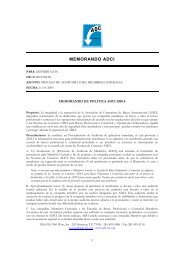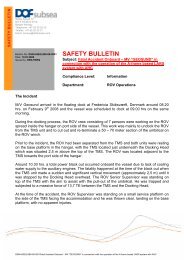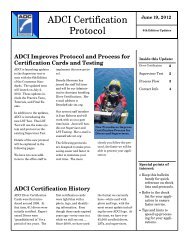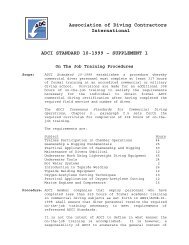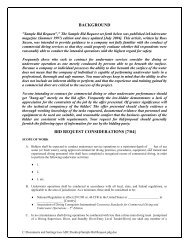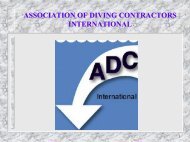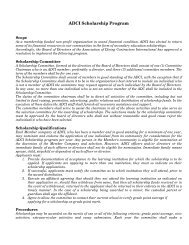DIRECTIVE NUMBER: CPL 02-00-151 EFFECTIVE DATE ... - OSHA
DIRECTIVE NUMBER: CPL 02-00-151 EFFECTIVE DATE ... - OSHA
DIRECTIVE NUMBER: CPL 02-00-151 EFFECTIVE DATE ... - OSHA
You also want an ePaper? Increase the reach of your titles
YUMPU automatically turns print PDFs into web optimized ePapers that Google loves.
e. 29 CFR 1910.427(c)(5). A diver-carried reserve breathing-gas supply shall<br />
be carried by each diver engaged in liveboating operations.<br />
M. 29 CFR 1910.430 Equipment.<br />
1. 29 CFR 1910.430(a) General. Every equipment modification, repair, test,<br />
calibration, or maintenance service must be recorded in a log or by means of a<br />
tagging system. The tag or log entry must include the date, the type of work<br />
performed on the equipment, and the name or initials of the person who<br />
performed the work. The CSHO shall check to ensure that the employer has<br />
recorded the information required by this provision. This information is used to<br />
determine whether the equipment meets the requirements of 29 CFR 1910.430<br />
or is in need of maintenance, testing, or replacement. These records (logs or<br />
tags) must be kept by the employer until replaced by a subsequent up-to-date<br />
record, or until the equipment is withdrawn from service.<br />
2. 29 CFR 1910.430(b) Air compressor system.<br />
a. 29 CFR 1910.430(b)(1) and (b)(2). Air compressor systems used to supply<br />
air to the diver must be equipped with a volume tank (VT), a check valve on<br />
the inlet side of the VT (to prevent loss of air if the compressor fails), a VT<br />
pressure gauge, a VT relief valve (to prevent excessive pressure buildup),<br />
and a VT drain valve (to drain or “bleed” accumulated moisture from the<br />
VT). In addition, the air compressor intakes must be located away (upwind)<br />
from any internal combustion engine exhaust or other contamination source<br />
to protect the diver’s breathing air.<br />
NOTE: Generally, an upwind horizontal separation of at least twelve feet<br />
should be maintained between the air compressor intake and the engine<br />
exhaust. In addition, the air intake should be located at least six feet above<br />
the ground, deck, or other low-lying area that could collect contaminants<br />
that are heavier than air. Even if a system is designed to keep the exhaust<br />
downwind of the intake (e.g., floating, weathervaning system), these<br />
horizontal and vertical distances should be maintained.<br />
b. 29 CFR 1910.430(b)(3) and (b)(4). The employer is responsible for<br />
checking the output of the air compressor system every 6 months to ensure<br />
that the diver’s breathing air does not contain more than 20 ppm (parts per<br />
million) by volume of carbon monoxide (CO), more than 1,<strong>00</strong>0 ppm by<br />
volume of carbon dioxide (CO 2 ), 5 milligrams per cubic meter of oil mist<br />
(except that non-oil-lubricated compressors need not be tested for oil mist),<br />
or a pronounced or noxious odor. The CSHO shall interview appropriate<br />
employees and examine the records indicating the results of such tests. The<br />
CSHO also shall check to ensure that the air sample was taken at the<br />
connection to the distribution system (manifold). The CSHO or industrial<br />
hygienist should obtain a sample of the breathing air for later evaluation or,<br />
when possible, test for contaminants onsite.<br />
35


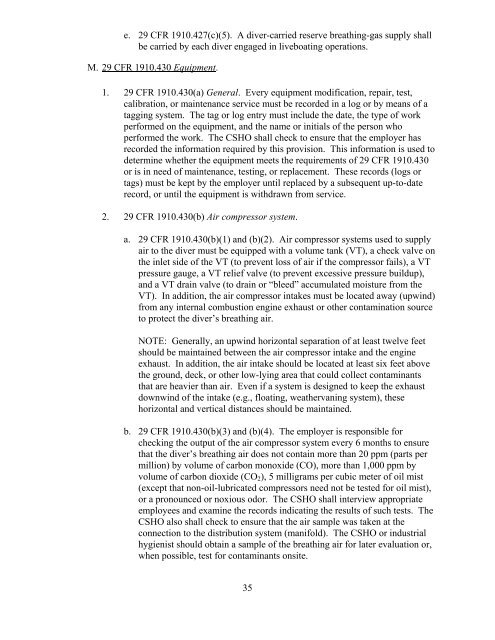
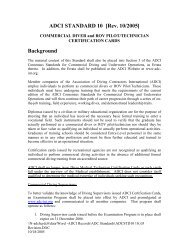
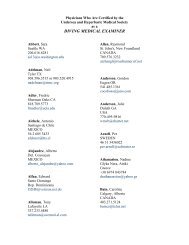
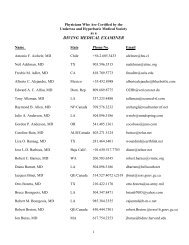
![SOLICITUD MEMBRESIA ASOCIADO [Rev 06/08] - Association of ...](https://img.yumpu.com/48291988/1/190x245/solicitud-membresia-asociado-rev-06-08-association-of-.jpg?quality=85)

